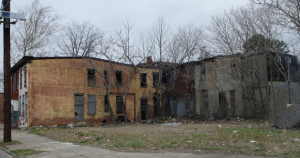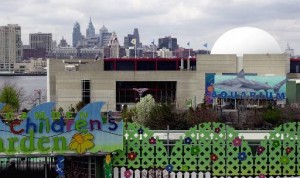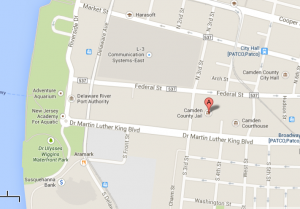By Emma Langston
The history of Camden, New Jersey is similar to those of many cities in the eastern United States; a rich, fruitful past left way to a current situation of uncertainty and dread. Now considered “the poorest city in the nation…also the most dangerous,” it has been deteriorating for years, with about ninety percent of the city’s land slated by politicians as redevelopment zones as of 2006 (Hedges, n. p. ; Ruilova 443). This, paired with mismanagement by its government and its ever-shrinking tax base, provides for a very tricky situation with respect to economic and community development. In this post, I will explore the recent attempt made by Camden planners to revitalize the city by investing in large-scale waterfront tourism.
Some social commentators describe Camden as a sort of doomed wasteland “…scarred with several thousand decaying abandoned row houses; the skeletal remains of windowless brick factories and gutted gas stations; overgrown vacant lots filled with garbage and old tires; neglected, weed-filled cemeteries; and boarded-up store fronts” (Hedges, n.p.). This description paints a sensationalized yet important picture of Camden, as it illustrates to visible consequences of the issues facing this city that are in turn inspiring planners to revitalize the community. The boarded-up store fronts are representative of the abysmal economic downturn that Camden faced after its major industrial players left the city; shipbuilding and metal processing factories, along with the infamous Campbell’s Soup and RCA-Victor record companies, dominated the waterfront and provided jobs to tens of thousands of Camden citizens before the deindustrialization of the area (Ruilova 444). The vacant lots, including the previously abandoned waterfront, symbolize the economic and spiritual loss the citizens of Camden incurred after this devastating loss and the massive depopulation of the city (Figure 1), which has “fallen by more than 40 percent from its 1950 level of over 120,000” to its current ~75,000 due to lack of jobs and disappearance of public services like schools, police, and infrastructure maintenance (Hedges, n.p.). This lack of infrastructure and vitality permeates almost every aspect of the city; as Hedges points out in his bleak depiction of the city, “there are no movie theaters or hotels…there are lots with used cars but no dealerships that sell new vehicles” (Hedges, n.p.).
The major strategic advantage of Camden is its location. Its neighboring city across the Delaware River, Philadelphia, is one of the largest, oldest cities in America, rich with art, culture, and history. In addition, over six major highways pass through the heart of Camden, making it virtually impossible for passersby to ignore its presence, and making the real estate potentially very valuable if high-demand industries were to invest in its development (Jargowsky).

Figure 1. These abandoned homes in Camden, NJ are just minutes from the developed waterfront area. This illustrates the hardship of the city and the challenges in integrating the tourist areas into the residential areas. (Source: Associated Press Images)
The planning committee in Camden was faced with tough predicament when convincing the public The Rehabilitation Act of 2002 allocated the $175 million in state aid to various development projects around Camden including investing in the public school system, the police force, and an extravagant plan for the redevelopment of Camden’s formerly bustling downtown (Ruilova 446). The waterfront complexes would be the main attractions, but the tourism industry would continue far inland, with lines of shops, restaurants, and seasonal attractions that would increase the foot traffic and economic stimulation in the city. The proposal aimed to create 50,000 jobs through the combined waterfront and downtown development, and it prioritized the employment of Camden’s residents (Ruilova 448). During the Camden Recovery Board meeting in July 2003, president Barry Rosenberg formerly announced his promise of job training for thousands of city residents, most of which would then be employed by the new waterfront complexes. The Board then unanimously approved the project.
After over five years of construction, the current Camden waterfront is home to a large concert venue, the Battleship New Jersey, Rutgers University’s Camden campus, the Victor luxury apartment complex, Campbell’s baseball stadium, a waterfront walkway that runs miles of the Delaware River, and the New Jersey state aquarium, which underwent a $25 million expansion completed in 2009 (Katz). This phase of the waterfront redevelopment has received much criticism since its completion.

The Adventure Aquarium, located on the Camden Waterfront, is one of the many attractions that were hopeful of bringing tourism and jobs to Camden, NJ. (Source: Associated Press Images/Brian Price)
The main argument about the development is that it was not designed with the citizens in mind and is poorly integrated into city as a whole, a situation that can be described as “necessary [for change], but not sufficient” (Jargowsky). Economically, it has not served its promised purpose of “job training for city residents” and increased Camdenite employment, two major selling points that drove the aquarium expansion project to a unanimous vote by the Camden Recovery Board. In fact, the percentage of aquarium employees hailing from Camden has dropped from around 40 percent before the renovation to around 20 percent in recent years (Katz).
The word “all-inclusive” comes to mind, as “visitors have no incentive to leave the premises” of the complexes in pursuit of food, shopping, or exploration of the city; these locations simply do not exist (Katz). “Once inside,” Katz describes, “they leave the downtrodden city behind, and they never really return” (Katz). Visitors not only see no need to leave the premises, but also no desire to do so, as Camden falls victim to its reputation time and time again; because these attractions are located just a couple of blocks from the county courthouse and the county jail (Figure 2), families rarely feel comfortable venturing out of the contained world of an aquarium campus. Even if there were new stores and restaurants in the surrounding area, it is probable that Camden’s reputation alone would deter many from frequenting these locations.

Figure 2. This map shows both the promise and pitfalls of the Camden waterfront. While the city is strategically close to Philadelphia, the Camden County Jail, marked by the red “A,” sits just a couple of blocks from the family-oriented waterfront. (Source: Google Maps)
This has caused outrage in the many community groups and citizens who expected the waterfront development to serve as a catalyst for community-building and employing Camden citizens. They consider the visitors unwelcome, as they represent the flaws in the development plan and the lack of care for Camden’s citizens. One community activist, Angel Cordero, stated his argument very concisely: “Give us jobs, fix our schools. Don’t give us fish, let us fish” (Katz, n.p.). This anger is justly rooted in feelings of distrust toward the parties in power in Camden, and there has been little commentary from the initial decision-makers on the criticisms of the development.
Sources:
Hedges, C. (2010, November 4). City of Ruins. The Nation. Retrieved October 14, 2013 from http://www.thenation.com/article/155801/city-ruins
Jargowsky, P. A. (2012, December 23). Camden’s Waterfront Development: Has it Worked? Rutgers Camden Online. Retrieved October 15, 2013 from http://jargowsky.rutgers.edu/2012/12/27/camdens-waterfront-development-has-it-worked/
Katz, M. (2009, November 9). Camden’s waterfront – and its woes. philly.com. Retrieved October 14, 2013 from http://articles.philly.com/2009-11-09/news/24987966_1_municipal-rehabilitation-poorest-city-aquarium
Ruilova, T. (2006). Camden 2015: Can Condemnation Power And Urban Redevelopment Plans Bring Life Back To The City? Rutgers Journal of Law and Urban Policy. 441, pp. 441-470. Retrieved October 15, 2013 from http://heinonline.org/HOL/Page?handle=hein.journals/rutjulp3&div=28&g_sent=1&collection=journals#441
